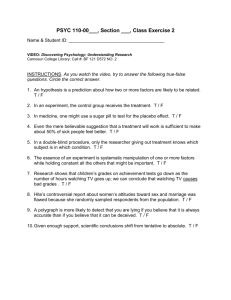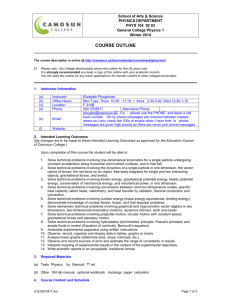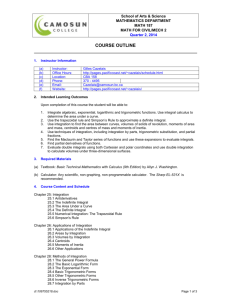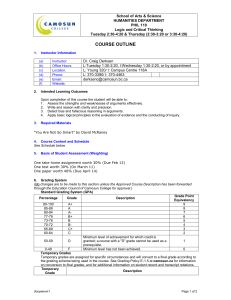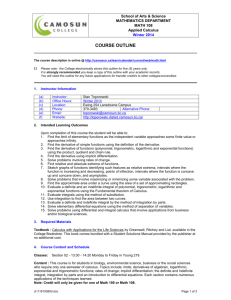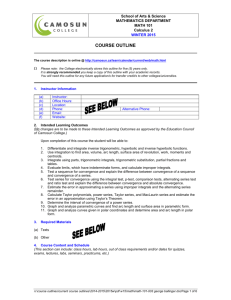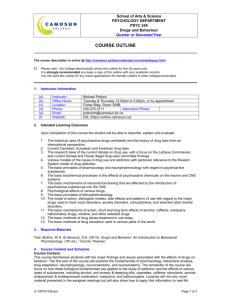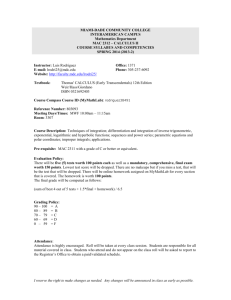MATH-101 - Camosun College
advertisement
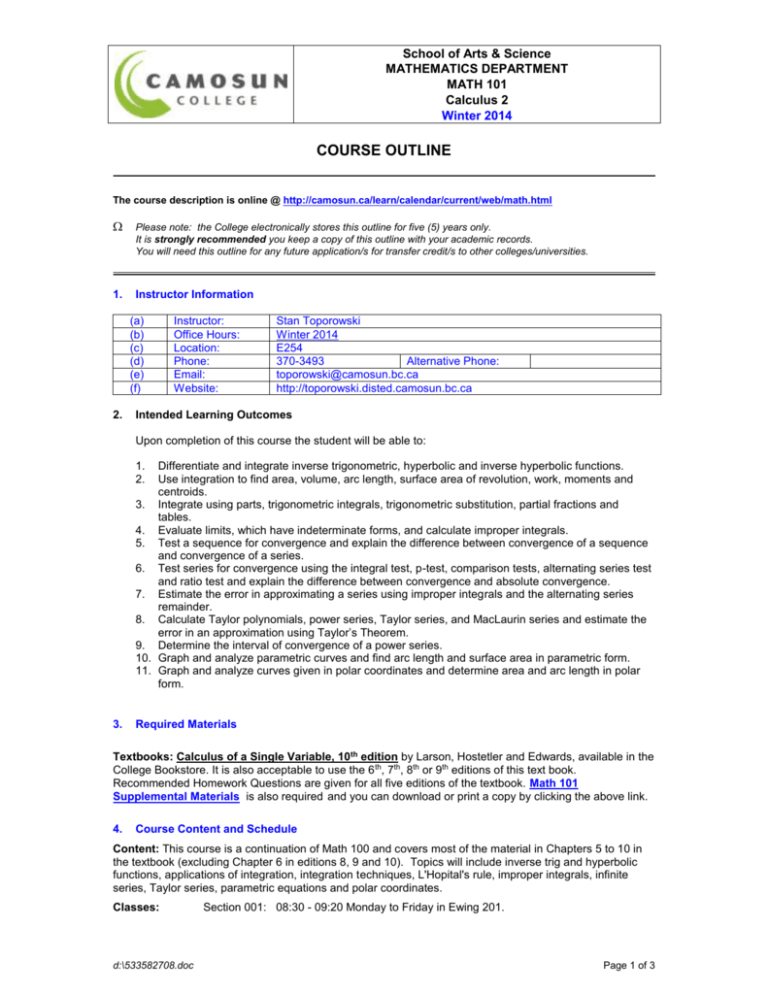
School of Arts & Science MATHEMATICS DEPARTMENT MATH 101 Calculus 2 Winter 2014 COURSE OUTLINE The course description is online @ http://camosun.ca/learn/calendar/current/web/math.html 1. Please note: the College electronically stores this outline for five (5) years only. It is strongly recommended you keep a copy of this outline with your academic records. You will need this outline for any future application/s for transfer credit/s to other colleges/universities. Instructor Information (a) (b) (c) (d) (e) (f) 2. Instructor: Office Hours: Location: Phone: Email: Website: Stan Toporowski Winter 2014 E254 370-3493 Alternative Phone: toporowski@camosun.bc.ca http://toporowski.disted.camosun.bc.ca Intended Learning Outcomes Upon completion of this course the student will be able to: 1. 2. Differentiate and integrate inverse trigonometric, hyperbolic and inverse hyperbolic functions. Use integration to find area, volume, arc length, surface area of revolution, work, moments and centroids. 3. Integrate using parts, trigonometric integrals, trigonometric substitution, partial fractions and tables. 4. Evaluate limits, which have indeterminate forms, and calculate improper integrals. 5. Test a sequence for convergence and explain the difference between convergence of a sequence and convergence of a series. 6. Test series for convergence using the integral test, p-test, comparison tests, alternating series test and ratio test and explain the difference between convergence and absolute convergence. 7. Estimate the error in approximating a series using improper integrals and the alternating series remainder. 8. Calculate Taylor polynomials, power series, Taylor series, and MacLaurin series and estimate the error in an approximation using Taylor’s Theorem. 9. Determine the interval of convergence of a power series. 10. Graph and analyze parametric curves and find arc length and surface area in parametric form. 11. Graph and analyze curves given in polar coordinates and determine area and arc length in polar form. 3. Required Materials Textbooks: Calculus of a Single Variable, 10th edition by Larson, Hostetler and Edwards, available in the College Bookstore. It is also acceptable to use the 6 th, 7th, 8th or 9th editions of this text book. Recommended Homework Questions are given for all five editions of the textbook. Math 101 Supplemental Materials is also required and you can download or print a copy by clicking the above link. 4. Course Content and Schedule Content: This course is a continuation of Math 100 and covers most of the material in Chapters 5 to 10 in the textbook (excluding Chapter 6 in editions 8, 9 and 10). Topics will include inverse trig and hyperbolic functions, applications of integration, integration techniques, L'Hopital's rule, improper integrals, infinite series, Taylor series, parametric equations and polar coordinates. Classes: d:\533582708.doc Section 001: 08:30 - 09:20 Monday to Friday in Ewing 201. Page 1 of 3 5. Basis of Student Assessment (Weighting) Prerequisites and Expectations: You must have a minimum grade of C in Math 100 or A in Math 108 in order to take Math 101. If you have the minimum requirement, you should be prepared to make an extra effort in order to maintain your standing as this course is quite demanding. If you feel that you might not have the necessary background, please see me in the first week of classes and we will talk about your situation. A grade of D in this course is considered as a pass, however if you intend to use this course as a prerequisite for Math 220 you will need a grade of at least C. Evaluation: Your final grade will be determined on the basis of Term Work worth 50% and a comprehensive Final Exam worth 50%. The final exam is 3 hours long and will be written during the week following the end of classes, the time and place will be scheduled by the College. Term work : The term work will consist of four in class tests and four hand in assignments. The class tests will count for 40% of your final mark, the assignments 10%. Dates for the tests will be announced in class at least a week in advance and dates will also be posted on the news page. Current term grades will be posted online and updated as new work is completed. Attendance: While attendance in classes is not mandatory, it is very difficult to be successful if you miss many classes. If you must miss classes due to illness or other reasons, let me know and I can give you an idea of what work was covered. I will also update the news page daily with information regarding what we covered that day and any announcements that were made in class. If you must miss a test due to illness, it is very important that you contact me so that we can make appropriate accommodations. 6. Grading System (No changes are to be made to this section unless the Approved Course Description has been forwarded through the Education Council of Camosun College for approval.) Standard Grading System (GPA) Percentage Grade 90-100 85-89 80-84 77-79 73-76 70-72 65-69 60-64 A+ A AB+ B BC+ C 50-59 D 0-49 F Description Minimum level of achievement for which credit is granted; a course with a "D" grade cannot be used as a prerequisite. Minimum level has not been achieved. Grade Point Equivalency 9 8 7 6 5 4 3 2 1 0 Temporary Grades Temporary grades are assigned for specific circumstances and will convert to a final grade according to the grading scheme being used in the course. See Grading Policy E-1.5 at camosun.ca for information on conversion to final grades, and for additional information on student record and transcript notations. Temporary Grade I IP CW d:\533582708.doc Description Incomplete: A temporary grade assigned when the requirements of a course have not yet been completed due to hardship or extenuating circumstances, such as illness or death in the family. In progress: A temporary grade assigned for courses that, due to design may require a further enrollment in the same course. No more than two IP grades will be assigned for the same course. (For these courses a final grade will be assigned to either the 3rd course attempt or at the point of course completion.) Compulsory Withdrawal: A temporary grade assigned by a Dean when an instructor, after documenting the prescriptive strategies applied and consulting with peers, deems that a student is unsafe to self or others and must be removed from the lab, practicum, worksite, or field placement. Page 2 of 3 7. Recommended Materials or Services to Assist Students to Succeed Throughout the Course LEARNING SUPPORT AND SERVICES FOR STUDENTS There are a variety of services available for students to assist them throughout their learning. This information is available in the College calendar, at Student Services, or the College web site at camosun.ca. STUDENT CONDUCT POLICY There is a Student Conduct Policy which includes plagiarism. It is the student’s responsibility to become familiar with the content of this policy. The policy is available in each School Administration Office, at Student Services, and the College web site in the Policy Section. Calculator Policy: The only calculator allowed for use on tests and the final exam for all Math courses is the Sharp EL-531X, available at the College Bookstore. Transferring to UVIC : If you intend to use this course as a prerequisite for Math 200 at UVIC, you may do so with a grade of D. However, be aware that the entry standard into the second year at UVIC can vary for different programs and any D grades will have a significant effect on your GPA. Resources : Math Lab (Ewing 224). This is a drop-in center where you can get help with your math homework. The hours will be posted on the door. I will post regular office hours, check my door for the times. Set up a regular study schedule !! You will probably have to do between 5 and 10 hours of homework a week to keep up. Recommended Homework: These study guides are a list of homework questions that you should do to get a full understanding of the course material, they are not to be handed in. You can print out the list of homework questions for the edition of the textbook that you are using. 6th edition d:\533582708.doc 7th edition 8th edition 9th edition 10th edition Page 3 of 3
